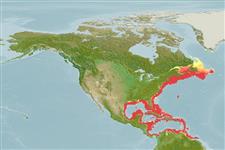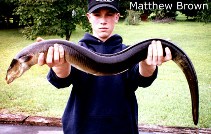Add your observation in Fish Watcher
| Native range | All suitable habitat | Point map | Year 2050 |

|
| This map was computer-generated and has not yet been reviewed. |
| Anguilla rostrata AquaMaps Data sources: GBIF OBIS |
Upload your photos and videos
Pictures | Sounds | Google imageAnguilla rostrata
Picture by The Native Fish Conservancy
Pictures | Sounds | Google imageAnguilla rostrata
Picture by The Native Fish Conservancy
Dominican Republic country information
Common names:
[No common name]
Occurrence: native
Salinity: freshwater
Abundance: | Ref:
Importance: commercial | Ref: Jacoby, D., J. Casselman, M. De Lucia and M. Gollock, 2017
Aquaculture: commercial | Ref: FAO, 1997
Regulations: | Ref:
Uses: no uses
Comments: Commercially cultured in the past (Ref. 7306). Also Ref. 117426.
National Checklist:
Country Information: https://www.cia.gov/library/publications/resources/the-world-factbook/geos/dr.html
National Fisheries Authority: ttp://www.cep.unep.org/rep_dom/Rep_Dom.htm#SEA-PESQUERO
Occurrences: Occurrences Point map
Main Ref: Wenner, C.A., 1978
National Database:
Occurrence: native
Salinity: freshwater
Abundance: | Ref:
Importance: commercial | Ref: Jacoby, D., J. Casselman, M. De Lucia and M. Gollock, 2017
Aquaculture: commercial | Ref: FAO, 1997
Regulations: | Ref:
Uses: no uses
Comments: Commercially cultured in the past (Ref. 7306). Also Ref. 117426.
National Checklist:
Country Information: https://www.cia.gov/library/publications/resources/the-world-factbook/geos/dr.html
National Fisheries Authority: ttp://www.cep.unep.org/rep_dom/Rep_Dom.htm#SEA-PESQUERO
Occurrences: Occurrences Point map
Main Ref: Wenner, C.A., 1978
National Database:
Common names from other countries
Classification / Names Common names | Synonyms | Catalog of Fishes(genus, species) | ITIS | CoL | WoRMS | Cloffa
Teleostei (teleosts) > Anguilliformes (Eels and morays) > Anguillidae (Freshwater eels)
Etymology: Anguilla: Latin, anguilla, .-ae = eel (Ref. 45335); rostrata: From the words Anguilla-Latin for eel and rostrata, meaning long nose (Ref. 10294).
More on author: Lesueur.
Etymology: Anguilla: Latin, anguilla, .-ae = eel (Ref. 45335); rostrata: From the words Anguilla-Latin for eel and rostrata, meaning long nose (Ref. 10294).
More on author: Lesueur.
Environment: milieu / climate zone / depth range / distribution range Ecology
Marine; freshwater; brackish; demersal; catadromous (Ref. 26938); depth range 0 - 464 m (Ref. 57178). Subtropical; 4°C - 25°C (Ref. 12468); 66°N - 5°N, 98°W - 21°W
Distribution Countries | FAO areas | Ecosystems | Occurrences | Point map | Introductions | Faunafri
Northwest to western Central Atlantic: Greenland south along the Atlantic coast of Canada and the USA to Panama, and throughout much of the West Indies south to Trinidad.
Length at first maturity / Size / Weight / Age
Maturity: Lm 68.5, range 37 - 100 cm
Max length : 152 cm TL male/unsexed; (Ref. 26938); 122.0 cm TL (female); common length : 50.0 cm TL male/unsexed; (Ref. 3242); max. published weight: 7.3 kg (Ref. 4699); max. reported age: 43 years (Ref. 40922)
Max length : 152 cm TL male/unsexed; (Ref. 26938); 122.0 cm TL (female); common length : 50.0 cm TL male/unsexed; (Ref. 3242); max. published weight: 7.3 kg (Ref. 4699); max. reported age: 43 years (Ref. 40922)
Short description Identification keys | Morphology | Morphometrics
Dorsal spines (total): 0; Anal spines: 0. Head rather long; eyes small and placed well forward on head. Lips thick. Caudal vertebrae without transverse processes. Premaxillae not developed as distinct elements in adults. Frontal bones paired, not grown together. Pectoral girdle with 7 to 9 (up to 11 in the young) radial elements. Adults usually white or light-colored below and brownish to blue-black above, but coloration is variable; young with some yellow on the edges of the dorsal and anal fins (Ref. 30499). Caudal fin rounded, joined to dorsal and anal fins. Gill opening on side in front of lower half of well-developed pectoral fin; lower jaw longer than upper; 103-111 vertebrae (Ref. 26938).
Occurs in streams, rivers, muddy or silt-bottomed lakes (Ref. 5951); usually in permanent streams with continuous flow (Ref. 86798). Hides during the day in undercut banks and in deep pools near logs and boulders (Ref. 86798). Feeds on larvae of Ephemeroptera, Odonata, Plecoptera, Coleoptera, Trichoptera, and Lepidoptera, as well as gastropods, oligochaetes, amphipods, isopods, mysids, and fish from the families Percidae, Cyprinidae, Ictaluridae, Catostomidae and Anguillidae (Ref. 9593). Migrates in autumn to the Sargasso Sea to spawn (Ref. 3242). Sexual maturity occurs approximately in less than10 years and up to 40 years in freshwater (Ref. 57533). Larvae (transparent leptocephali shaped somewhat like a willow leaf) hatch and develop at sea to metamorphose into elvers in nearshore waters and estuaries (Ref. 57533). Adults are caught with eel pots and trot lines. Elvers and glass eels are caught with fine mesh fyke nets and dipnets. Catadromous species. (Ref. 26938). Maximum depth reported taken from Ref. 57178.
Life cycle and mating behavior Maturity | Reproduction | Spawning | Eggs | Fecundity | Larvae
Undertakes migration in autumn to the Sargasso Sea where spawning is said to take place. Coloration changes with sexual maturation. Dorsal surface of the pectorals becomes dark, lateral line becomes prominent, eye diameter increases and visual pigments change, body takes on a silvery bronze coloration. Females are usually larger than males and migrate much farther upstream (Ref. 57533). Adults die after spawning (Ref. 30499).
Spawn at sea but growth occurs in estuaries or freshwater (Ref. 7135). Spawning grounds believed to be between 20° and 30°N and 60°and 75°W (Ref. 40916, 40917).
Main reference
Upload your references | References | Coordinator | Collaborators
Page, L.M. and B.M. Burr, 1991. A field guide to freshwater fishes of North America north of Mexico. Houghton Mifflin Company, Boston. 432 p. (Ref. 5723)
IUCN Red List Status (Ref. 130435: Version 2024-2)
Endangered (EN) (A2bd); Date assessed: 08 November 2020
Threat to humans
Harmless
Human uses
Fisheries: commercial; aquaculture: commercial; gamefish: yes; aquarium: public aquariums
FAO(Aquaculture systems: production; Fisheries: production; publication : search) | FishSource | Sea Around Us
More information
Population dynamics
Growth parameters
Max. ages / sizes
Length-weight rel.
Length-length rel.
Length-frequencies
Mass conversion
Recruitment
Abundance
Growth parameters
Max. ages / sizes
Length-weight rel.
Length-length rel.
Length-frequencies
Mass conversion
Recruitment
Abundance
Life cycle
Reproduction
Maturity
Fecundity
Spawning
Spawning aggregations
Eggs
Egg development
Larvae
Larval dynamics
Reproduction
Maturity
Fecundity
Spawning
Spawning aggregations
Eggs
Egg development
Larvae
Larval dynamics
Physiology
Body composition
Nutrients
Oxygen consumption
Swimming type
Swimming speed
Visual pigments
Fish sound
Diseases & Parasites
Toxicity (LC50s)
Body composition
Nutrients
Oxygen consumption
Swimming type
Swimming speed
Visual pigments
Fish sound
Diseases & Parasites
Toxicity (LC50s)
Human related
Aquaculture systems
Aquaculture profiles
Strains
Ciguatera cases
Stamps, coins, misc.
Aquaculture systems
Aquaculture profiles
Strains
Ciguatera cases
Stamps, coins, misc.
Tools
Bio-Quiz | E-book | Field guide | Length-frequency wizard | Life-history tool | Point map | Classification Tree
| Catch-MSY |
Special reports
Download XML
Internet sources
Alien/Invasive Species database | Aquatic Commons | BHL | Cloffa | BOLDSystems | Websites from users | Check FishWatcher | CISTI | Catalog of Fishes(genus, species) | DiscoverLife | DORIS | ECOTOX | Faunafri | Fishtrace | GenBank(genome, nucleotide) | GloBI | GOBASE | GoMexSI (interaction data) | | Google Books | Google Scholar | Google | IGFA World Record | MitoFish | National databases | Otolith Atlas of Taiwan Fishes | PubMed | Reef Life Survey | Scirus | SeaLifeBase | Tree of Life | Wikipedia(Go, Search) | World Records Freshwater Fishing | Zoological Record
Estimates based on models
Preferred temperature (Ref. 115969): 0.5 - 24.3, mean 6.3 (based on 323 cells).
Phylogenetic diversity index (Ref. 82804): PD50 = 0.5000 [Uniqueness, from 0.5 = low to 2.0 = high].
Bayesian length-weight: a=0.00087 (0.00070 - 0.00108), b=3.18 (3.13 - 3.23), in cm Total Length, based on LWR estimates for this species (Ref. 93245).
Trophic level (Ref. 69278): 3.8 ±0.2 se; based on diet studies.
Resilience (Ref. 120179): Low, minimum population doubling time 4.5 - 14 years (tm=3-6; tmax=43; Fec=5,000,000).
Fishing Vulnerability (Ref. 59153): High to very high vulnerability (72 of 100).
Climate Vulnerability (Ref. 125649): High vulnerability (60 of 100).




